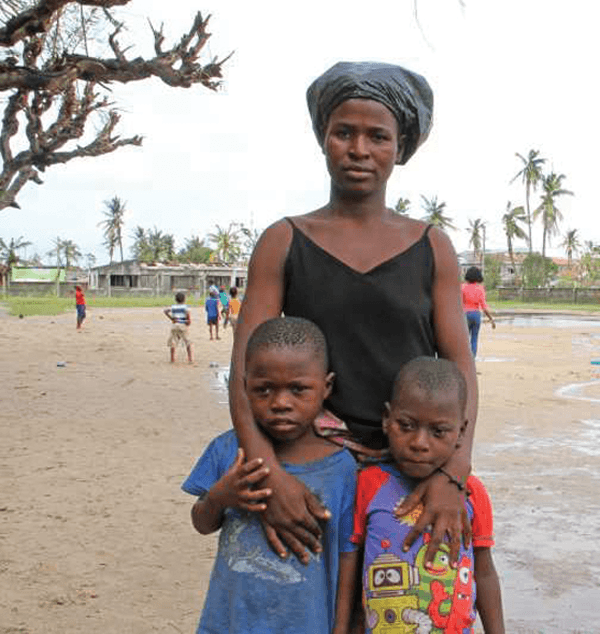
MAPUTO — Ahead of the United Nations secretary-general’s visit to Mozambique, where he will witness first-hand the devastating impact of two consecutive cyclones, OCHA’s Saviano Abreu recounts his unexpected meeting with Hortencia, one of the first survivors he met four months ago, shortly after Cyclone Idai destroyed her home.
They met again this past Sunday at Mandruzi resettlement site, where Hortencia and her children are rebuilding their lives.
I first met Hortencia on 19 March, just four days after Cyclone Idai tore through Mozambique.
The single young mother of three was staying in an overcrowded accommodation centre in the Escola Industrial in Beira.
She was one of the first people I interviewed in Mozambique, and while her story is similar to that of many other people I have encountered since then, I will never forget talking with her.
Hortencia lost everything that night. She had to flee her home in the middle of the night to find a safe place for herself and her children after their house collapsed.
She was terrified of losing her children, as roofs and trees were falling everywhere around them.
When we met, Hortencia told me that the small business she used to run would not be able to reopen, and she didn’t know how she would manage to survive.
- Chamisa under fire over US$120K donation
- Mavhunga puts DeMbare into Chibuku quarterfinals
- Pension funds bet on Cabora Bassa oilfields
- Councils defy govt fire tender directive
Keep Reading
What struck me about Hortencia was her smile and her determination. Despite her hardships, she repeatedly told me how thankful she was to be alive and how grateful she was for the efforts being made to assist the survivors of the cyclones.
At that point, food and water were still scarce for many families living in the transit centres.
Last Sunday, I was part of a team that visited the Mandruzi resettlement site. Part of my duties in Mozambique include talking to people who receive humanitarian assistance, which mainly involves listening to them — to hear how they live and what their biggest needs are.
Suddenly, I heard someone call my name and looked up to see a familiar figure running towards me.
It was Hortencia, with a huge smile on her face. She gave me a big hug and said: “Do you remember me? I am so happy to see you again!”
We walked around the site and talked about her life these past four months.
She thought it was no coincidence that we had met in the first place. Seeing Hortencia again made me realise the importance of the human aspect in our work as humanitarians as we help survivors to rebuild their lives and strengthen their resilience to future shocks.
Hortencia and her children currently live in Mandruzi resettlement site. This is their new home, far from the many at-risk zones in Beira.
More than 60 000 people affected by Cyclone Idai are living in the same site as they try to build a new life after losing everything.
Hortencia and the other residents received clothing, pots, plates and dignity kits, as well as access to a clinic.
The camp also provides a safe space for women, access to clean, potable water, and latrines within a short distance.
“I dream of a place I can call home where I can raise my children,” Hortencia says. “I am alone, I don’t have a job. Will I ever have the means to build a house? But then again, I am alive, my children are alive, while I know so many people who improvised shacks with metal sheets from roofs that were blown off during the cyclone … Many of them didn’t make it. I can’t complain. It has been a difficult few months, but I am fine now.”
Hortencia tells me that she is growing vegetables such as cassava, to go along with the food she receives at the site.
“They finally look healthy!” she says of her three children.
Over 1,8 million people have received food in Manica, Sofala, Tete and Zambezia, although concerns remain about a possible food crisis.
Before the cyclones hit, nearly 900 000 people in Mozambique were severely food insecure due to drought in the southern part of the country.
After the cyclone, more than 715 000 hectares of crops were damaged, just before the harvest. Fishing boats were destroyed, and livestock died.
Without adequate support to rebuild people’s livelihoods, more than 1,8 million people will continue to need food assistance across the country.
The future for Hortencia and her family is still uncertain. Finding a job in the new place she lives will not be easy.
Spots to cultivate crops are still not available, and she is worried that her children do not have a formal school functioning nearby.
“Are they going to be able to get an education in the future? I want them to have a better life than mine,” she says.
More than 3 500 classrooms have been destroyed or damaged across Manica, Sofala, Tete and Zambezia provinces, which has left more than 335 100 children without education and at least 7 830 teachers without a job.
And while humanitarian partners have created hundreds of temporary learning spaces, only 14% of school-age children can access a formal school within a 15- minute walking distance from where they live.
Hortencia’s children are among the remaining 86% who have to walk at least an hour to get to a formal school.
About $441 million needed to continue to respond to the ongoing needs, only 35% has been funded.
At the same time, the Mozambican government and development partners need an estimated $3,2 billion to rebuild damaged homes and infrastructure.
unocha.org











